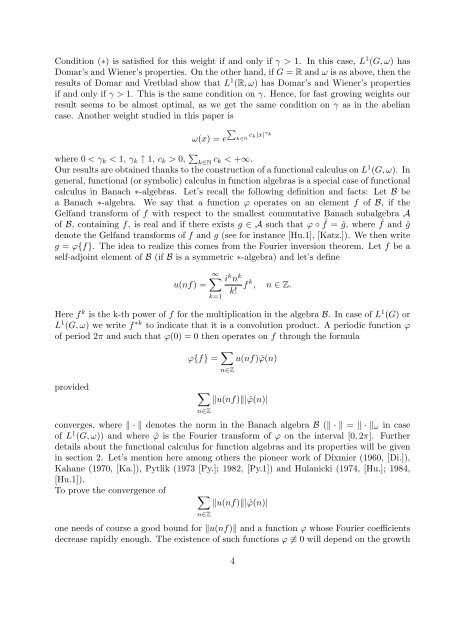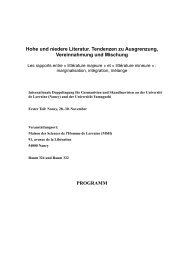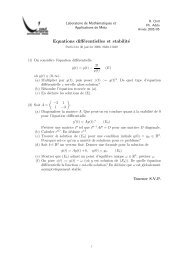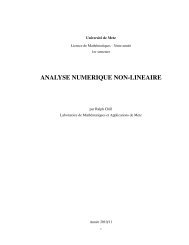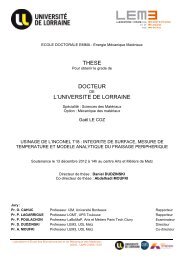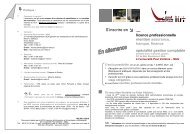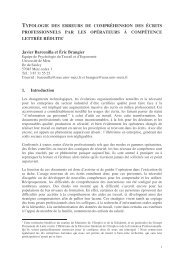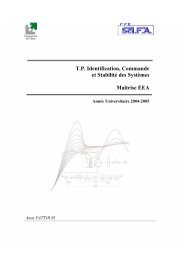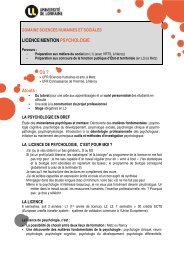Functional calculus in weighted group algebras
Functional calculus in weighted group algebras
Functional calculus in weighted group algebras
You also want an ePaper? Increase the reach of your titles
YUMPU automatically turns print PDFs into web optimized ePapers that Google loves.
Condition (∗) is satisfied for this weight if and only if γ > 1. In this case, L 1 (G, ω) hasDomar’s and Wiener’s properties. On the other hand, if G = R and ω is as above, then theresults of Domar and Vretblad show that L 1 (R, ω) has Domar’s and Wiener’s propertiesif and only if γ > 1. This is the same condition on γ. Hence, for fast grow<strong>in</strong>g weights ourresult seems to be almost optimal, as we get the same condition on γ as <strong>in</strong> the abeliancase. Another weight studied <strong>in</strong> this paper is∑ω(x) = ec k|x| γ kk∈Nwhere 0 < γ k < 1, γ k ↑ 1, c k > 0, ∑ k∈N c k < +∞.Our results are obta<strong>in</strong>ed thanks to the construction of a functional <strong>calculus</strong> on L 1 (G, ω). Ingeneral, functional (or symbolic) <strong>calculus</strong> <strong>in</strong> function <strong>algebras</strong> is a special case of functional<strong>calculus</strong> <strong>in</strong> Banach ∗-<strong>algebras</strong>. Let’s recall the follow<strong>in</strong>g def<strong>in</strong>ition and facts: Let B bea Banach ∗-algebra. We say that a function ϕ operates on an element f of B, if theGelfand transform of f with respect to the smallest commutative Banach subalgebra Aof B, conta<strong>in</strong><strong>in</strong>g f, is real and if there exists g ∈ A such that ϕ ◦ ˆf = ĝ, where ˆf and ĝdenote the Gelfand transforms of f and g (see for <strong>in</strong>stance [Hu.1], [Katz.]). We then writeg = ϕ{f}. The idea to realize this comes from the Fourier <strong>in</strong>version theorem. Let f be aself-adjo<strong>in</strong>t element of B (if B is a symmetric ∗-algebra) and let’s def<strong>in</strong>eu(nf) =∞∑ i k n kf k , n ∈ Z.k!k=1Here f k is the k-th power of f for the multiplication <strong>in</strong> the algebra B. In case of L 1 (G) orL 1 (G, ω) we write f ∗k to <strong>in</strong>dicate that it is a convolution product. A periodic function ϕof period 2π and such that ϕ(0) = 0 then operates on f through the formulaϕ{f} = ∑ n∈Zu(nf) ˆϕ(n)provided∑‖u(nf)‖| ˆϕ(n)|n∈Zconverges, where ‖ · ‖ denotes the norm <strong>in</strong> the Banach algebra B (‖ · ‖ = ‖ · ‖ ω <strong>in</strong> caseof L 1 (G, ω)) and where ˆϕ is the Fourier transform of ϕ on the <strong>in</strong>terval [0, 2π]. Furtherdetails about the functional <strong>calculus</strong> for function <strong>algebras</strong> and its properties will be given<strong>in</strong> section 2. Let’s mention here among others the pioneer work of Dixmier (1960, [Di.]),Kahane (1970, [Ka.]), Pytlik (1973 [Py.]; 1982, [Py.1]) and Hulanicki (1974, [Hu.]; 1984,[Hu.1]).To prove the convergence of ∑‖u(nf)‖| ˆϕ(n)|n∈Zone needs of course a good bound for ‖u(nf)‖ and a function ϕ whose Fourier coefficientsdecrease rapidly enough. The existence of such functions ϕ ≢ 0 will depend on the growth4


